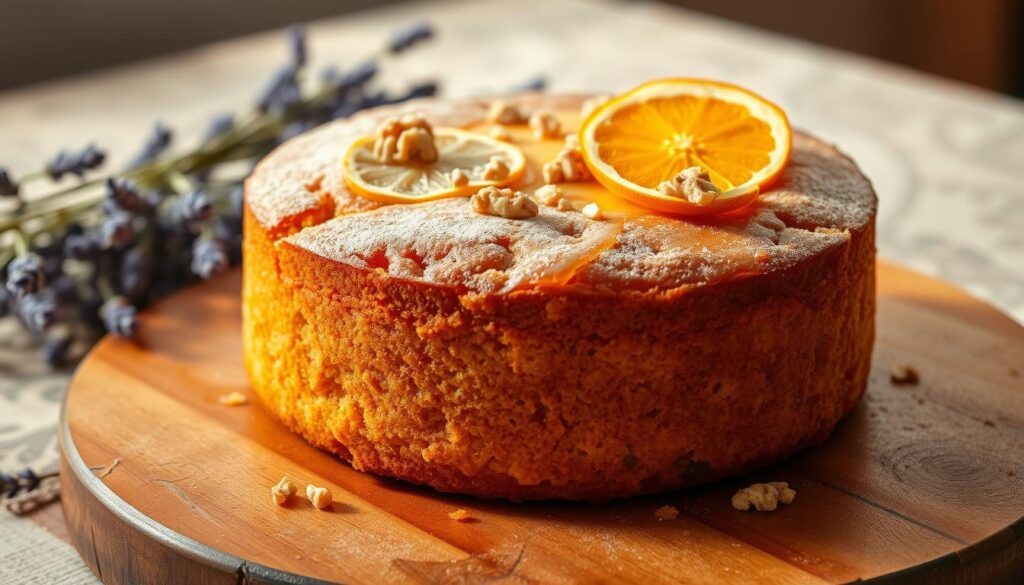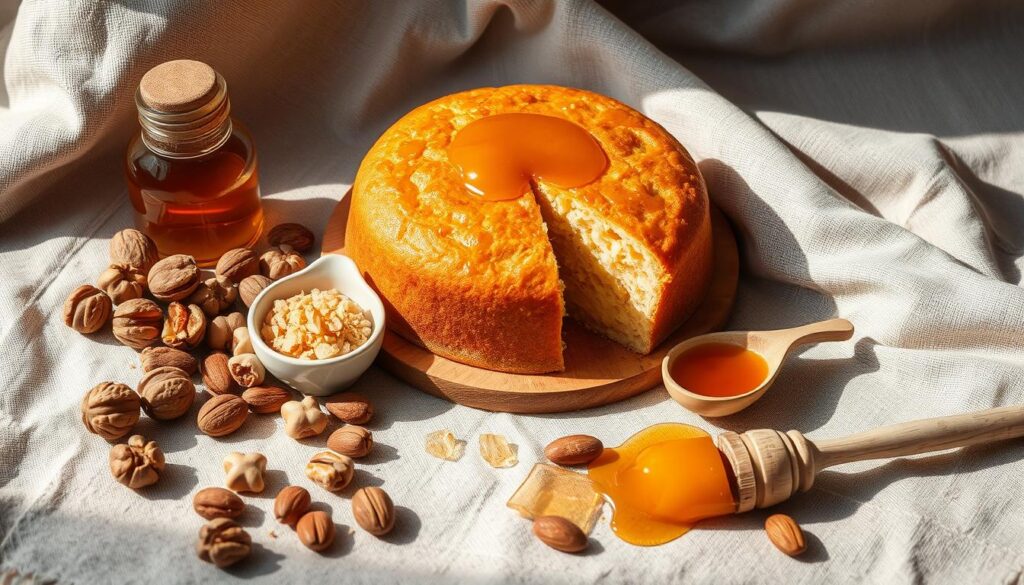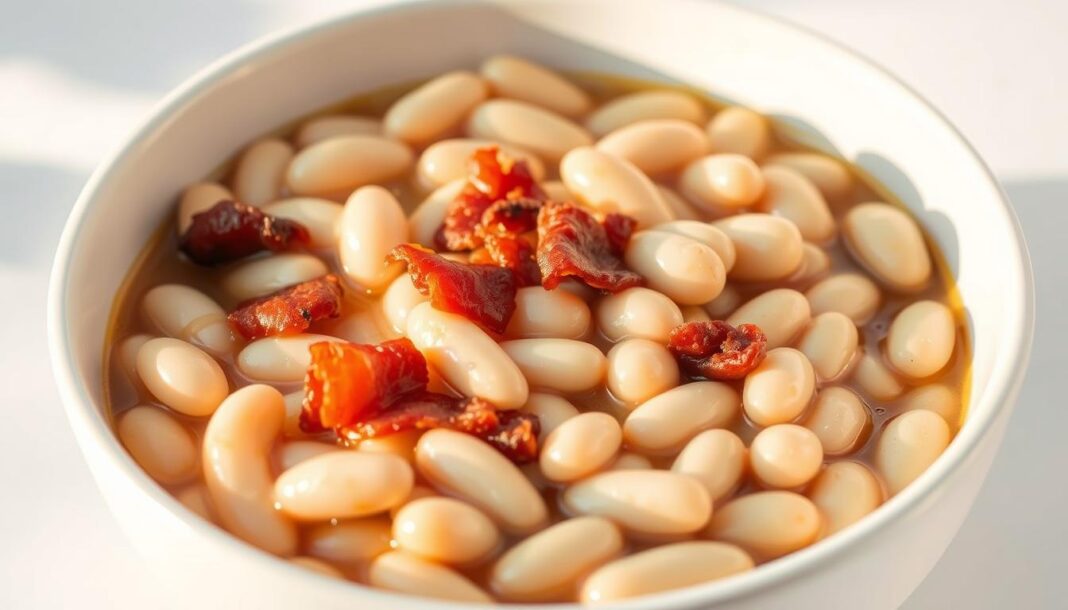Indulge in the rich flavors of a traditional honey cake, a beloved dessert with deep historical roots. At Historical Foods, we’re excited to share our comprehensive guide to baking this delightful treat. With its signature thin layers and creamy filling, the Russian Medovik style is a classic variation that stands out among many versions of honey cakes.
Our tested recipe produces a cake that’s rich in honey flavor without being overwhelmingly sweet. By understanding the science behind honey’s unique properties in baking, you’ll achieve a perfect balance of moisture and sweetness. Whether you’re a seasoned baker or trying honeycake for the first time, our step-by-step approach ensures consistent, delicious results. For more on the history of honeycakes, visit our page on honeycakes.
The Rich History and Tradition of Honeycake
The honeycake, a dessert steeped in tradition, has a rich history that spans centuries and crosses multiple cultures. As we delve into its past, we discover that this beloved treat is more than just a sweet indulgence; it’s a reflection of cultural heritage and traditional baking practices.
Origins of Medovik: Russia’s Beloved Honey Cake
Medovik, Russia’s cherished honey cake, has its roots in the former USSR. This multi-layered cake has become an iconic dessert, not just in Russia but internationally, captivating the hearts of dessert enthusiasts worldwide. The traditional Russian recipe for medovik involves layers of honey-infused cake stacked with creamy fillings, creating a delightful harmony of flavors and textures. The use of honey as a primary ingredient not only adds a distinct flavor but also pays homage to the historical significance of honey as a sweetener in Russian cuisine.

Why Honey Was the Original Sweetener
Before the widespread use of refined sugar, honey was the primary sweetener in many cultures, including ancient Russia. The natural preservative qualities of honey made it an ideal ingredient for baked goods, allowing them to remain fresh for longer periods. This characteristic, combined with its rich flavor, made honey a staple in traditional baking. The tradition of using honey in baking has been passed down through generations, influencing the development of various desserts, including the beloved honeycake. As we explore the history of honeycake, we gain a deeper appreciation for the role of honey in shaping culinary traditions.
Essential Ingredients for the Perfect Honeycake
Selecting the finest ingredients is the first step towards creating an unforgettable honeycake. The quality of your honey cake is directly tied to the components you choose, making it crucial to understand the role of each ingredient.
We recommend using high-quality ingredients to ensure your honeycake turns out rich and flavorful. The foundation of a great cake lies in its fundamental ingredients, which include flour, butter, and eggs.
The Foundation: Flour, Butter, and Eggs
The type of flour used in honeycake is crucial for its texture. We recommend using all-purpose flour for its reliable protein content, which provides the perfect structure for honeycake’s distinctive texture. Unsalted butter contributes richness and helps create the tender crumb that distinguishes exceptional honeycakes from ordinary ones. Fresh eggs act as both binding agents and leaveners, contributing to the cake’s structure while adding richness to the flavor.

Choosing the Right Honey for Your Cake
Almost any runny honey will work in this recipe. For a mellower flavor, stick to milder honeys like wildflower or clover. For a more intense honey flavor, dark honeys like buckwheat, chestnut, or leatherwood will work well. The type of honey you select will dramatically influence your cake’s character.
Spices and Flavorings That Complement Honey
Traditional spices like cinnamon, nutmeg, and cloves enhance honey’s natural warmth without overwhelming its delicate floral qualities. A pinch of ground cinnamon, for example, can add depth to your honeycake. Typically, a teaspoon of ground spices is sufficient to make a noticeable difference.
By understanding the function of each ingredient and choosing the best quality components, you’ll be well on your way to baking a honeycake that’s both delicious and memorable.
Step-by-Step Honeycake Baking Guide
The process of baking a honeycake involves several key steps, each crucial to achieving the perfect texture and flavor, which we’ll walk you through. To start, let’s prepare the foundation of our honeycake.
Preparing the Cake Batter
To begin, we need to prepare the cake batter. In a medium-sized bowl, sift together flour, cornstarch, baking powder, baking soda, salt, and ground cinnamon. Using a whisk, mix until well combined and set aside. In a large bowl, combine melted butter, oil, vanilla, and eggs. Whisk until smooth and well combined, then set aside. In a small bowl, mix milk and honey. Heat this mixture in the microwave or in a saucepan over the stove until it’s hot to the touch, stirring occasionally.
Once the honey and milk mixture is ready, we can combine it with the other ingredients. The sequence of ingredient incorporation significantly impacts the final texture of your cake layers. By following our steps, you’ll achieve a smooth batter that’s ready for baking.
Baking the Cake Layers to Perfection
To bake the cake layers to perfection, preheat your oven to the required temperature. Roll out the batter to your desired thickness, using parchment paper to prevent sticking. This step is crucial for achieving evenly baked layers. Place the rolled-out batter in the oven and bake for the specified minutes. Repeat this process until you have the desired number of layers.
Precise temperature control is essential when baking the thin layers—our guide will help you achieve perfectly even baking without over-browning.
Creating the Creamy Filling
The cream filling is a crucial component of the honeycake, requiring careful attention to achieve the right consistency. To create it, you’ll need to mix the ingredients until they’re smooth and well combined. The key is to find a balance between firmness and softness, ensuring that the cream holds the layers together without overpowering the cake.
By following our step-by-step guide, you’ll be able to create a delicious honeycake with a perfectly balanced cream filling and delicate cake layers.
Expert Tips for Honeycake Success
From temperature control to assembly techniques, our expert tips will guide you through the process of creating the perfect honeycake. With years of experience and extensive testing, we’ve identified key factors that make a difference in achieving honeycake perfection.
Achieving Even, Thin Layers
To achieve even, thin layers, it’s crucial to maintain a cool environment – both for the dough and your working space. Using parchment paper both under and over the dough when rolling creates the most even layers and prevents frustrating tears or sticking. For traditional Medovik, we recommend using a cake ring or template to trim layers to identical sizes, creating a visually striking even appearance when sliced.
Proper Assembly Techniques
Assembling the honeycake requires patience and attention to detail. Start by placing a layer on a serving plate or cake stand, then spread a thin, even layer of cream on top. Repeat this process, finishing with a layer of cream on top. To prevent crumbs from getting stuck in the cream, use a crumb coat – a thin layer of cream that seals the cake layers.
Resting and Storage Recommendations
The resting period is non-negotiable – allowing your assembled cake to rest for at least 8 hours (preferably overnight) transforms the texture as the layers absorb moisture from the filling. To store, cover the cake with multiple layers of plastic wrap and refrigerate. For longer storage, honeycake can be frozen loosely wrapped in plastic wrap and placed inside an airtight container for up to one month. Thaw overnight in the refrigerator.
Serving and Enjoying Your Homemade Honeycake
Serving honeycake is an art that enhances its rich flavors and textures, making every occasion special. Traditionally, honeycake is served chilled, which not only highlights its distinctive texture but also allows the complex honey flavors to shine through. We recommend cutting it into thin slices due to its richness; a little goes a long way, and thin slices beautifully showcase the layering.
For an elegant presentation, consider dusting the top with powdered sugar or crushed cake crumbs, or garnish with fresh berries to complement the honey notes. Honeycake pairs beautifully with unsweetened tea, providing a pleasant contrast to the cake’s natural sweetness. The flavor of honeycake actually improves over time—day-old cake often tastes better than freshly made, as the honey notes deepen and the textures meld.
For special occasions, serving honeycake with a dollop of lightly sweetened whipped cream or a scoop of vanilla ice cream creates a more elaborate dessert. In various Eastern European cultures, honeycake holds significance at celebrations and holidays, showcasing its versatility for both casual family gatherings and formal entertaining. Leftover honeycake can be repurposed into delightful trifles by layering cake pieces with additional cream and fresh fruit. To keep honeycake fresh, store it in the fridge for up to three days, wrapping it loosely in plastic wrap or transferring slices to an airtight container.
Tips for Storage: Store in the fridge for up to three days. Wrap loosely in plastic wrap to prevent drying, or transfer slices to an airtight container.


